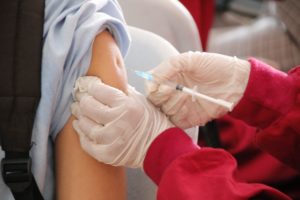GERMANY – August 11, 2023 – Does it make any difference if a series of vaccinations are in the same arm or different arms? According to a study from Germany that was recently published in eBioMedicine (a peer-reviewed journal from The Lancet Discovery Science series), the first vaccination of the 2-dose COVID-19 series can produce a strong immune response and the 2nd shot induces a stronger response if it was in the same arm than if it was in the other arm. Therefore, this study supports having all vaccinations from the series in the same arm to achieve the highest protection against getting infected and severe disease.
More than 300 hundred immunocompetent persons without a history of COVID-19 were enrolled in this observational study. They were randomized so that about half had both COVID-19 shots in the same arm and the other half had them in different arms. The 2 groups were similar in age and sex distribution and with blood test evaluation between the number of white blood cells and its cells that fight infection and make antibodies to fight infection.
Some vaccine-sensitive diseases require more than one shot to achieve a good immunization response that is essential in fighting infections. Examples are COVID-19, rabies, tetanus and haemophilus influenza type b (h. flu.) diseases. Many people can’t remember which arm had the first shot. They may get the shots in their non-dominant arm to avoid soreness in their dominant arm.
The immune response after sequential vaccinations has been previously studied by injection site. There was one study of adults after a 4-dose rabies vaccination series and one British study for infants after a 3-dose h. flu regimen, a 3-dose tetanus regimen, and a 3-dose pneumococcal series. In the adult study, there was a higher immune response with injections to the same arm. In the study of children, there was no difference in site-specificity for the pneumococcal and tetanus cohort. In contrast, the h. flu group showed a higher immune response after the second injection in the different leg group than in the same leg.
The vaccine is administered in adults via injection into the deep part of the thick deltoid muscle which surrounds the shoulder. The vaccine is drained into the lymph nodes within the axillary region of the same side, at the junction between the upper arm and the chest wall. These lymph nodes become larger than the other side indicating a higher metabolic activity in response to the shot. Previous studies have shown that the white blood cells responsible for the immune response are stimulated after one vaccination and multiply after a second shot in the same arm. People who had injections into the same arms had a stronger immunogenic response after the subsequent shots than persons injected into different arms.
In contrast to adults, children are injected into the upper thigh region. In children, the upper thigh region does not drain into lymph nodes specific to the same side of the body. Each side merges in the pelvis. The children who had repeat shots on the same side did not have a stronger immune response than if they had their shots in different legs.
Choosing which arm to have the second or sequential vaccination has never been felt to be important. This study shows that adults have a higher immune response following a series of COVID-19 vaccinations if they are in the same arm. Having a higher immune response should be more effective in preventing COVID infection and severe disease. This may be very important for elderly and immunocompromised people who do not usually mount a strong immune response. Injections in the same arm may also be more protective against other vaccine-specific disease that requires more than one vaccination.
Listen to the full report below:
Contact: Dr. Dick Needleman, Health reporter, 103.3 AshevilleFM, healthyasheville@ashevillefm.org
